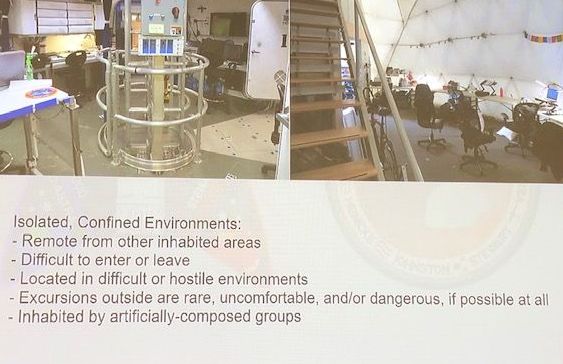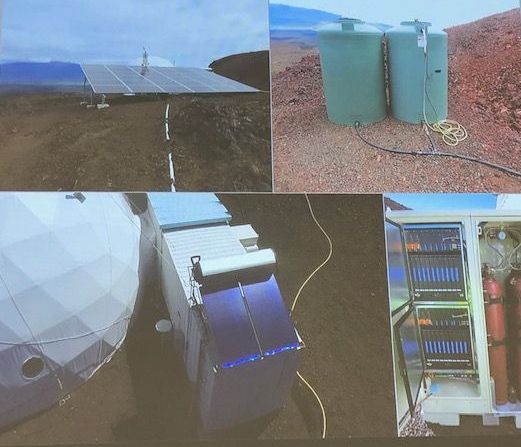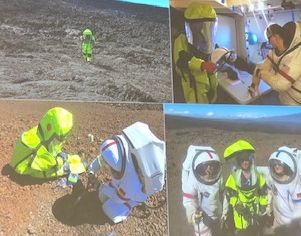
Andrzej earned degrees in Aerospace Engineering from the University of Texas at Austin and the Massachusetts Institute of Technology, and aspires to be a NASA astronaut. In pursuing that, he has served as the Flight Engineer of HERA C2M2, a two-week asteroid mission simulation at the Johnson Space Center, and as Chief Engineering Officer of HI-SEAS IV, a year-long Mars simulation in Hawaii.
Andrzej spoke about the challenges of travel to Mars and his experiences in the mission simulations at JSC and Hawaii and provided a number of photos from those missions. Andrzei started his presentations by showing photos of what earth looked like as one travels to mars. The first photo was of the Johnson Space Center here in Houston from close orbit, then a photo of the earth seen as a complete globe, the earth as seen from the moon and finally the earth as seen from mars. From mars, the earth like like a tiny dot in the sky.
Andrzei than spoke about how incredibly long a trip to mars and back would be and how everything you need has to be carried with you. When in space, money no longer matters as the most important things are those thinks that keep you alive (Power, Food & Water, Air and Time). He spoke of how NASA prepares for these missions by simulating the environments for crews to be subjected to. Andrzei showed the environment for his first two week asteroid mission simulation (see below) where the crew quarters were extremely tight.

Andrzei then spoke about his year long role as Chief Engineering Officer of HI-SEAS IV, a year-long Mars simulation in Hawaii. The site was actually on the side of a volcano where the landscape was much like it might be on mars (see below). The crew was allowed to go outside occasionally but only when in space suits to get simulated soil samples.


Andrzei also spoke about how the crew had to be able to fix any component when spare parts were not available. They sometimes had to take two non-working parts to create one working part. He also spoke about the food and water they had to use. The water had to be reused wherever possible and they worked until they got the crew down to just 4 gallons a day in water usage. The food had to be freeze dried so that it could be stored easier and for much longer periods of time. However, for fun, the crew came up with an interesting Thanksgiving dinner (see below) that was as close as they could get to the real thing.

Andrzei also spoke about communications between mars and the earth. It seem than when the earth and mars were the closest, it took about 3 minutes for a message to go one way. However, when the earth and mars were at their furthermost apart, a message would take 22 minutes to go one way. Therefore, the crew had to practice messaging by sending a message, waiting 22 minutes before receiving an answer to their message and then wait another 22 minutes to send their response to the last message. Andrzei explained it could easily take 45 minutes just to say hello at that speed.
Andrzei then answered several questions from the members of the Magnolia Rotary Club before leaving the meeting. Everyone really liked Andrzei's presentation as they felt like they were given some insider information on how the mission simulations are carried out at NASA.





